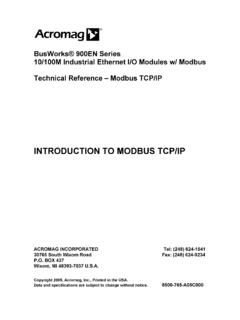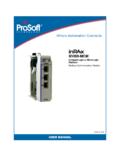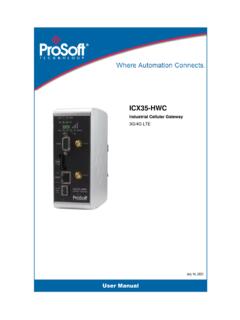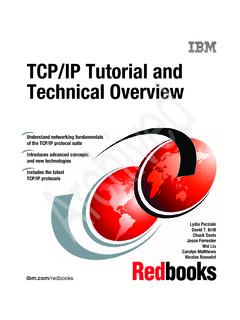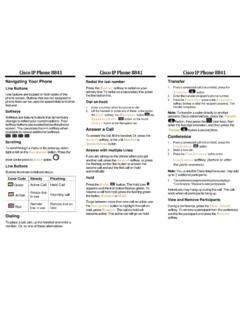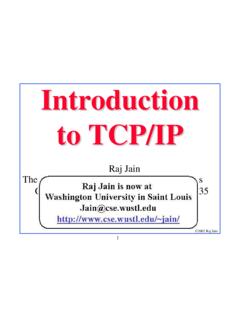Transcription of Introduction to Modbus TCP/IP
1 BusWorks 900EN Series 10/100M Industrial Ethernet I/O Modules w/ Modbus Technical Reference Modbus TCP/IP Introduction TO Modbus TCP/IP ACROMAG INCORPORATED Tel: (248) 624-1541 30765 South Wixom Road Fax: (248) 624-9234 BOX 437 Wixom, MI 48393-7037 Copyright 2005, Acromag, Inc., Printed in the USA. Data and specifications are subject to change without notice. 8500-765-A05C000 Introduction To Modbus TCP/IP _____ _____ Acromag, Inc. Tel:248-624-1541 Fax:248-624-9234 2 Introduction TO Modbus TCP/IP Modbus AND Modbus 3 What is Modbus ?.. 3 What is Modbus TCP/IP ?.. 4 Why Combine Modbus With Ethernet?
2 5 What About Determinism?.. 6 THE OSI NETWORK 7 TCP/IP 9 Key Concepts & 12 APPLICATION 13 Modbus Functions & 13 Read Coil Status (01).. 16 Read Holding Registers (03).. 18 Read Input Registers (04).. 18 Force Single Coil (05).. 19 Preset Single Register (06).. 20 Force Multiple Coils (15).. 20 Preset Multiple Registers (16).. 21 Report Slave ID (17).. 22 Modbus 23 Modbus TCP/IP ADU 25 Connection 27 TRANSPORT 29 TCP Transport Control 29 TCP 31 NETWORK 33 IP Internet 33 Ethernet (MAC) 35 Internet (IP) 35 ARP Address Resolution 37 RARP Reverse Address Resolution 38 DATA LINK (MAC) 40 CSMA/CD Carrier Sense Multiple Access 40 MAC Media Access Control (MAC) 40 Ethernet (MAC) 41 This information is provided as a service to our customers and to others interested in learning more about Modbus TCP/IP .
3 Acromag assumes no responsibility for any errors that may occur in this document, and makes no commitment to update, or keep this information current. Be sure to visit Acromag on the web at Windows is a registered trademark of Microsoft Corporation. Modbus is a registered trademark of Modicon, Incorporated. All trademarks are the property of their respective owners. TABLE OF CONTENTS Introduction To Modbus TCP/IP _____ _____Acromag, Inc. Tel:248-624-1541 Fax:248-624-9234 3 The following information describes the operation of Modbus TCP/IP as it relates to Acromag Series 900EN-40xx I/O modules. For more detailed information on Modbus , you may also refer to the Modicon Modbus Reference Guide , PI-MBUS-300 Rev J, available via download from Acromag manufactures a line of I/O modules that support Modbus over RS485, and Modbus over Ethernet.
4 Feel free to visit our website at to obtain the latest information about these and other Acromag products. The Modbus protocol was developed in 1979 by Modicon, Incorporated, for industrial automation systems and Modicon programmable controllers. It has since become an industry standard method for the transfer of discrete/ analog I/O information and register data between industrial control and monitoring devices. Modbus is now a widely-accepted, open, public-domain protocol that requires a license, but does not require royalty payment to its owner. Modbus devices communicate using a master-slave (client-server) technique in which only one device (the master/client) can initiate transactions (called queries). The other devices (slaves/servers) respond by supplying the requested data to the master, or by taking the action requested in the query.
5 A slave is any peripheral device (I/O transducer, valve, network drive, or other measuring device) which processes information and sends its output to the master using Modbus . The Acromag I/O Modules form slave/server devices, while a typical master device is a host computer running appropriate application software. Other devices may function as both clients (masters) and servers (slaves). Masters can address individual slaves, or can initiate a broadcast message to all slaves. Slaves return a response to all queries addressed to them individually, but do not respond to broadcast queries. Slaves do not initiate messages on their own, they only respond to queries from the master. A master s query will consist of a slave address (or broadcast address), a function code defining the requested action, any required data, and an error checking field.
6 A slave s response consists of fields confirming the action taken, any data to be returned, and an error checking field. Note that the query and response both include a device address, a function code, plus applicable data, and an error checking field. If no error occurs, the slave s response contains the data as requested. If an error occurs in the query received, or if the slave is unable to perform the action requested, the slave will return an exception message as its response (see Modbus Exceptions). The error check field of the slave s message frame allows the master to confirm that the contents of the message are valid. Traditional Modbus messages are transmitted serially and parity checking is also applied to each transmitted character in its data frame.
7 At this point, It s important to make the distinction that Modbus itself is an application protocol, as it defines rules for organizing and interpreting data, but remains simply a messaging structure, independent of the underlying physical layer. As it happens to be easy to understand, freely available, and accessible to anyone, it is thus widely supported by many manufacturers. Modbus AND Modbus TCP/IP What is Modbus ? Introduction To Modbus TCP/IP _____ _____ Acromag, Inc. Tel:248-624-1541 Fax:248-624-9234 4 Modbus TCP/IP (also Modbus -TCP) is simply the Modbus RTU protocol with a TCP interface that runs on Ethernet. The Modbus messaging structure is the application protocol that defines the rules for organizing and interpreting the data independent of the data transmission medium.
8 TCP/IP refers to the Transmission Control Protocol and Internet Protocol, which provides the transmission medium for Modbus TCP/IP messaging. Simply stated, TCP/IP allows blocks of binary data to be exchanged between computers. It is also a world-wide standard that serves as the foundation for the World Wide Web. The primary function of TCP is to ensure that all packets of data are received correctly, while IP makes sure that messages are correctly addressed and routed. Note that the TCP/IP combination is merely a transport protocol, and does not define what the data means or how the data is to be interpreted (this is the job of the application protocol, Modbus in this case). So in summary, Modbus TCP/IP uses TCP/IP and Ethernet to carry the data of the Modbus message structure between compatible devices.
9 That is, Modbus TCP/IP combines a physical network (Ethernet), with a networking standard ( TCP/IP ), and a standard method of representing data ( Modbus as the application protocol). Essentially, the Modbus TCP/IP message is simply a Modbus communication encapsulated in an Ethernet TCP/IP wrapper. In practice, Modbus TCP embeds a standard Modbus data frame into a TCP frame, without the Modbus checksum, as shown in the following diagram. DataVariesDataDataModbus TCP/IP ADU(2 Bytes)LengthFieldUnit ID(2 Bytes)ProtocolIdentifierModbus Application Protocol (MBAP) Header(7 Bytes)(1 Byte)Function CodeProtocol Data Unit (PDU)Function CodeChecksumFunction CodeApplication Data Unit (ADU)(This information is embedded into the data portion of the TCP frame)(2 Bytes)(1 Byte)TransactionIdentifierModbus Frame WithTCP/IP TransmissionFunction Code & DataAre Not ModifiedAddressTraditionalModbus Serial FrameCONSTRUCTION OF AMODBUS TCP DATA PACKET The Modbus commands and user data are themselves encapsulated into the data container of a TCP/IP telegram without being modified in any way.
10 However, the Modbus error checking field (checksum) is not used, as the standard Ethernet TCP/IP link layer checksum methods are instead used to guaranty data integrity. Further, the Modbus frame address field is supplanted by the unit identifier in Modbus TCP/IP , and becomes part of the Modbus Application Protocol (MBAP) header (more on this later). What is Modbus TCP/IP ? Introduction To Modbus TCP/IP _____ _____Acromag, Inc. Tel:248-624-1541 Fax:248-624-9234 5 From the figure, we see that the function code and data fields are absorbed in their original form. Thus, a Modbus TCP/IP Application Data Unit (ADU) takes the form of a 7 byte header (transaction identifier + protocol identifier + length field + unit identifier), and the protocol data unit (function code + data).
